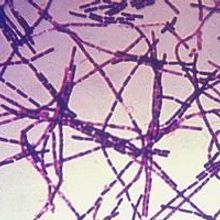H5N1 virus

Deciphering the Unusual Pattern of Bird Flu Symptoms in Cows
Danielle Gerhard, PhD | May 15, 2024 | 6 min read
The distribution of flu virus receptors in cow mammary glands helps explain the high H5N1 viral loads in milk, but it also raises concerns about risks to human health.

Unprecedented Avian Flu Epidemic Could Presage Year-Round Outbreaks
Christie Wilcox, PhD | Oct 4, 2022 | 2 min read
Nearly 50 million birds have been culled amid efforts to mitigate the spread of the virus, which continues to ravage the Northern Hemisphere.

CDC Reassigns Lab Regulation Chief
Bob Grant | Dec 9, 2015 | 2 min read
After a string of breaches involving anthrax, Ebola, and bird flu, the US Centers for Disease Control and Prevention has reportedly replaced the director of its Division of Select Agents and Toxins.

Hope for Universal Flu Vax?
Jef Akst | Aug 26, 2015 | 2 min read
Two studies point to the possibility that a single vaccine could protect against every strain of flu virus.

Moratorium on Gain-of-Function Research
Jef Akst | Oct 21, 2014 | 2 min read
In the wake of a handful of biosafety lapses at federal research facilities, the US government is temporarily halting funding for new studies aiming to give novel functions to influenza, SARS, and MERS viruses.

Dangerous Research Regs Released
Jef Akst | Sep 25, 2014 | 2 min read
The US government releases its policy on so-called dual-use research involving dangerous pathogens that could be used for biological terrorist attacks.

Haste Caused CDC Bird Flu Contamination?
Jef Akst | Aug 19, 2014 | 1 min read
The Centers for Disease Control and Prevention scientist who accidentally leaked H5N1 into a benign strain of avian influenza may have been rushing off to a meeting.

First North American H5N1 Death
Abby Olena, PhD | Jan 9, 2014 | 1 min read
A person in Canada has died of the first confirmed human case of H5N1 avian flu in North America.

European Researchers Urge H5N1 Caution
Bob Grant | Jan 2, 2014 | 2 min read
A group of scientists has called on the European Commission to evaluate the risks and benefits of research that could make deadly viruses more transmissible.

H5N1 Vaccine Approved
Jef Akst | Nov 25, 2013 | 2 min read
The US Food and Drug Administration OKs a vaccine against the virus that last year had the scientific community debating the regulation of deadly pathogen research.

H5N1 Researcher Continues Legal Battle
Bob Grant | Nov 6, 2013 | 2 min read
The Dutch scientist who mutated a strain of the avian flu virus to be transmissible between mammals is headed to appeals court to protect his right to publish the work unimpeded.

Safe Flu Research Strategy
Chris Palmer | Aug 12, 2013 | 1 min read
Researchers develop a new “molecular biocontainment” strategy for safely studying deadly flu viruses.

Week in Review: August 5–9
Jef Akst | Aug 9, 2013 | 5 min read
Flu researchers propose H7N9 studies; NIH makes deal to share HeLa genome; herbal “remedies” can cause cancer; scientists record grid cell activity in humans

Regulating Dangerous Research
Kate Yandell | Feb 23, 2013 | 2 min read
The US government has come out with new rules for life science research deemed risky.

Special Review for H5N1 Grants?
Jef Akst | Dec 4, 2012 | 2 min read
The National Institutes of Health reveals a controversial plan to regulate the funding of H5N1 research.
Rapid Bird Flu Test
Cristina Luiggi | Jun 4, 2012 | 1 min read
New PCR assay can detect more than 40 strains of H5N1 in a single go.
Extended H5N1 Moratorium?
Cristina Luiggi | Apr 30, 2012 | 2 min read
A US science official recommends extending moratorium on bird flu studies as well as other types of risky research.
Publish H5N1 Papers, Says US Gov’t
Jef Akst | Apr 23, 2012 | 1 min read
The NIH agrees with the government advisory board’s recommendation to publish both controversial bird flu studies in full.
White House Weighs in on H5N1
Jef Akst | Apr 18, 2012 | 1 min read
Science adviser John Holdren speaks out about how the Presidential Administration is handling the controversial research that rendered avian flu transmissible between ferrets.
